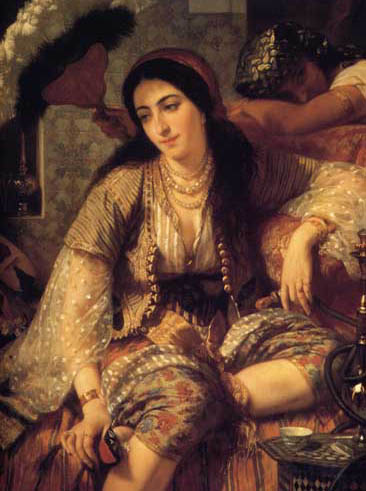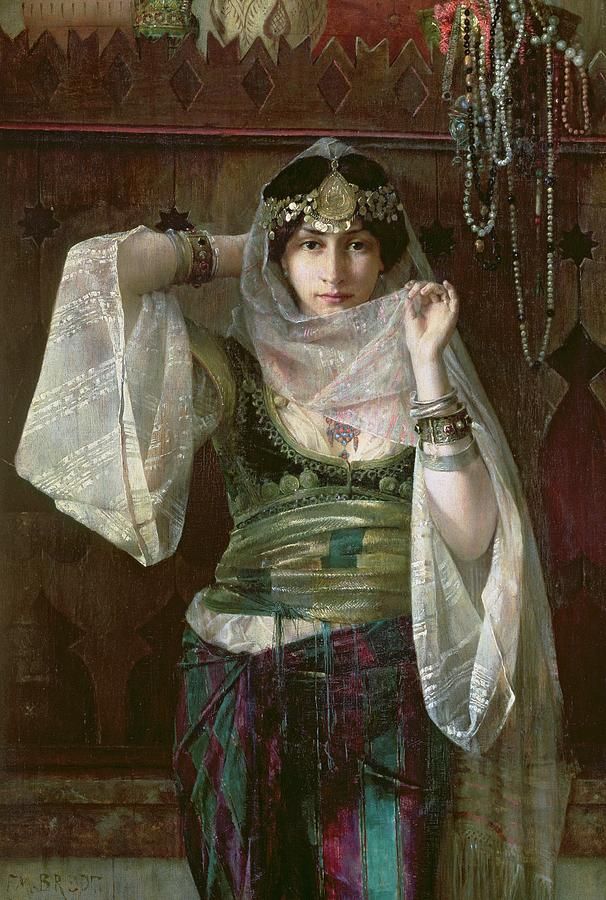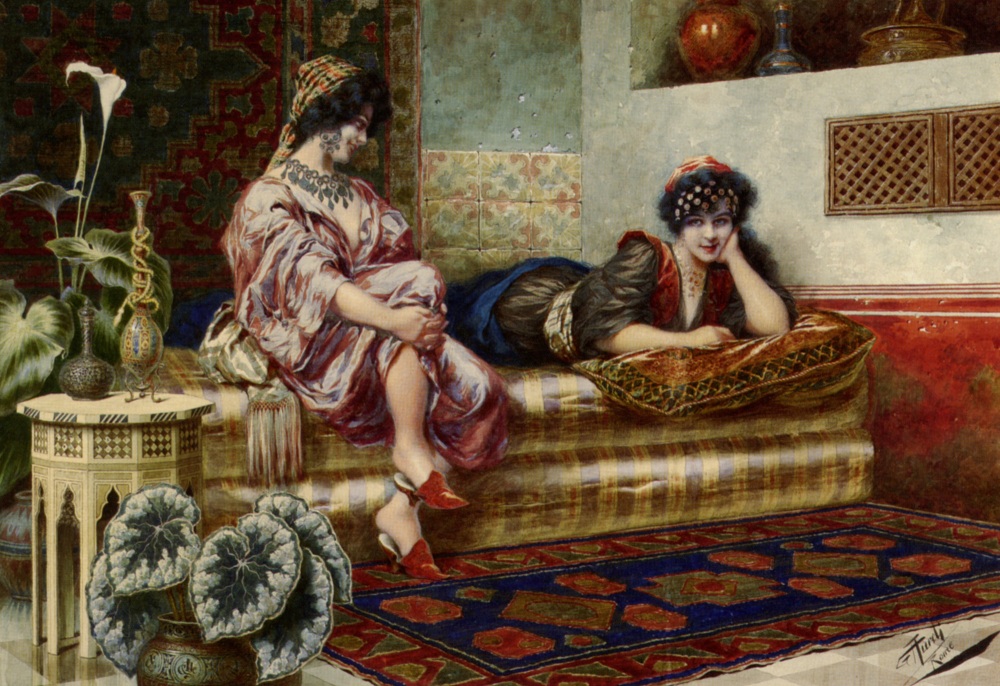
Rarely have women in history played a more deliciously mysterious role than that of the 600 years of the Ottoman Empire when what is modern-day Turkey sat at the center of a great Empire. These were the days of the harem when women – and girls as young as seven years old – were held in a secret world where they could be governed, educated, and primarily enjoyed by the sultan and his court.

But as slaves or subjects? Given as gifts or claimed as spoils of war, these women represented the Caliphate’s power, wealth, and sexual prowess. Just like a scene from Arabian Nights, daily life in an Ottoman harem was a life suspended in a secret paradise full of sensual delights – as well as endless rules, expectations, and boundaries. Derived from the Arabic word haram meaning sacred or forbidden, the harem was part of a legendary patriarchy that tried to bottle the essence of woman, capture it in all its glory, and use it solely for its own felicity.

During the 8th and 9th centuries, Turkish nomads were pushed from their homes, eventually converting to Islam when the Mongols arrived on the scene. As the new Ottoman Empire grew, it brought about a lot of changes for the region, including taxation, social shifts, and a great deal of religious indoctrination. Between 1299 and 1923 CE, it also brought about a cultural phenomenon known as “The Imperial Harem,” which held all the wives, servants, female relatives, and sultans’ concubines in the court. As the Empire expanded its territory, sultans came and went; economic and social institutions evolved from the Byzantine, and Islam became the pervasive law of the land. But one thing that did not change was the need for women and the deep-seated desire to dominate them.

Like a secret womb, tucked away from the prying eyes of an unstable world, the entrance to a harem was hidden away in the center of an elaborate court. Inside, women were enclosed in a gilded cage of luxury, protected yet completely divested of freedom. Placed in an ethereal world of green and blue tiled rooms, outlined in gold and lined with plush furniture, the outside world became a distant notion, only glimpsed through the occasional view of the Sea of Marmara.

Although its trappings were luxurious, replete with stained glass and looming arches, the imperial harem’s rooms took on an air of the perverse when viewed for the prison it was. Although it’s worth noting that both early Christian and Jewish women were also confined to private realms where they were expected to perform female duties, it was never done on such a formal scale until the caliphate of the Ottomans deemed it acceptable. The women of the harem were kept in seclusion and guarded by eunuchs who prevented them from doing basically anything. No one was allowed to see them unless first carefully inspected by senior officials who ensured there was no funny business on either end. And when the Sultan traveled, his court and his entire harem were expected to pick up and follow him in accordance with very strict traditions and guidelines.

To understand the role of the harem in the sultan’s court, it’s key to visualize the mind-blowing excess of basically everything around the ruler. Not only did he have a whole court filled with admirers, but the majority of those people were also expected to serve him in a very specific way – the harem included. There was a branch of servants who traveled with him, pages who served him, men who carried his weapons, a guy to help him mount his horse, a special designer for his turban, a dude to give him a perfect shave every day (which probably pleased the harem ladies a lot), a steward who tasted and carried his food, water, and wood throughout the palace and lit all the fires in the evening, and several hundred people responsible for opening all the doors of the palace in the event that he might want to pass through.

And the harem? They provided the essential framework of female influence for the Sultan—socially, emotionally, aesthetically, logistically, sexually—and fulfilled the complex roles of mother, daughter, sister, wife, mistress, and whore. They were always at his disposal, at his whim, and without the ability to think or reach beyond the confines of their gender. The difference with the harem versus his other courtesans is that they did not offer him a certain product – they were the product. And their service was their very lives.

Although it could easily be likened to a prison, the actual surroundings of the harem were beyond gorgeous. The center of the harem dwellers’ realm was a great pavilion with a giant courtyard where the women could bathe in a pool or gaze upon a garden. It was blissfully peaceful and quiet, a place where contemplation and rest were commonplace. The courtyard was a gathering space for the women to read together, pray, or just share stories, and it offered a much-needed escape from the interiors of their confinement. There was a view of the city, which likely offered them a sense of inclusion in the outside world, although they would rarely see that bustling area in person, if ever. Within their gilded cage were private apartments for the sultan and more than 400 rooms for sleeping, entertaining, and living.

The Imperial Harem typically housed scores of women, including the sultan’s official wives, mother, daughters, female relatives, and servant girls. And of course, the eunuchs were always watching in the wings for any impropriety. The sons of the sultan also lived in the harem until they were about 12 years old, at which point they were considered men and allowed to appear as palace courtesans. The realm was considered a profoundly intimate and private place where no man outside the sultan’s inner circle could lay his eyes. As a result, the harem had to be guarded by those who were domineering yet somehow not sexualized as male. This was perfectly achieved through eunuchs, castrated men tasked with guarding and protecting the women. They served as the medium – physically and symbolically – between the male and female worlds and were considered the hybrid gender fit to fully partake in both realms. Convenient, right?

Eunuchs were typically slaves who had been captured in war or purchased on some far-flung platform in Ethiopia or Sudan. There were two kinds of men in this role – black and white – and their appearance and general roles were considerably different. The black eunuchs, or Sandali, had their genitals completely removed during the process and were the most preferred for harem service as a result. The white eunuchs were allowed to keep at least some of their penis or testicles and were thus awarded fewer harem duties, as there was always a risk they might use what little they had left. All serving under one chief harem eunuch known as the Master of the Girls, or Kızlar Ağası, the black eunuchs were charged with guarding the women and often rose in rank, occupying many positions in the palace like vizier, confidante, or even a general in the army. Meanwhile, the white eunuchs served under the Kapı Ağası and had the privilege of handling state matters and other issues of “inner service” to the sultan.

Despite their limited status, women of the caliphate were not always left weak and vulnerable. Insomuch as men deemed acceptable, figures within the harem were able to exert considerable influence over the Ottoman Empire during the 16th and 17th centuries – a time known as the Sultanate of Women. Granted, many of the sultans of the time were minors who were adhering to their mothers’ dominion, but this was an unusual development, especially given the slave origins of many harem women. Despite the male concern for such practices, they were often off fighting (or planning their next strategic battle) and didn’t keep a tight reign on the infrastructure of their political landscape. But when the struggle between two of the most powerful female regents -Kösem Sultan and Turhan Sultan – ended in 1687, so did this famous reign of women. After that, the sultans no longer campaigned for war but retired to the comforts of the harem where they could detach themselves from world affairs and spend their time in pampered reflection.
The word odalisque – which was used to refer to many women in the harem – is originally from the Turkish odalık meaning “chambermaid” and only offers a glimpse of what women really did in the harem. Otherwise known as ikbals, these women were the sultan’s mistresses, yet they were also more than just mere bed warmers. Odalisques were always attractive in some way and usually possessed a level of talent, whether it be in music, dancing, or singing. They had been officially approved by both the Valide Sultan and the first wife. In fact, any visiting male guest visiting who received an odalisque as a gift of the sultan had surely been honored.

The women below the odalisque were called gedik and were noticed by the royal powers but not bedded—unless of course, the sultan decided to change that—mostly, these women seductively served him Baklava in the evening. Below the gedik were basic servants who did the same thing, but with much less cleavage. The majority of these women could technically be labeled concubines, as the word very loosely translated to “one-night-stand.” How much the sultan enjoyed said “stand” determined the trajectory of her future. Talk about performance anxiety.
The harem was essentially a small world inside a larger one, where the mother, or Valide Sultan, reigned supreme. She was not only the most important relative to the man himself, but she was also politically and socially influential in many ways. She selected the concubines for her son (because that makes sense), and she was the main person the women of the harem rallied around when they needed something, wanted to make alliances or pressed their personal agendas. She was the queen bee and could instantly decide the fate of any regular harem woman by either casting her out or promoting her within.

To have her on your side was paramount, as a secure place in the imperial harem could guarantee a woman protection, food, comforts, and even status. After all, if a concubine bore the Sultan a son, she could feasibly take a major role in the court someday. If the Valide Sultan found a woman wanting, she could easily marry them off to whomever she pleased, most likely some eligible bachelor from the Ottoman nobility. Or she could just send the poor girl home to a life of poverty and nothingness. She could monitor how much certain wives and their children saw the sultan and how their sons were introduced at court. But, of course, the Valide Sultan was only as good as her son, as his death would mean the end of her matriarchal reign. Second to her was the sultan’s “first wife” who was deemed such because – wait for it – she had the most sons.
Despite its confines, not all the women of the sultan’s harem were slaves. Within it were many of his wives who had the distinct pleasure of living in close proximity to all his concubines. Technically, the sultan’s wives were “free,” as they had been accepted into a marriage of their own will. This probably created some noticeable tension over kebabs in the evening, but there was no alternative. The women of the harem simply had to accept one another and find a way to embrace their strange liaisons.

Despite westernized fantasy, not all harem women were expected to sleep with the sultan. In fact, they all received a light education equivalent to that of a male page and were often bred to be married off to members of the court, outside nobility, or the Ottoman political elite. They could also just stay in the harem and serve the whims of the Valide Sultan. While it’s true that many of the beautiful and bright slave girls in the harem had been either captured in war or found by alternative means, they soon became absorbed into the larger system, evolving into imperial court ladies who would likely move on to a brighter future. The relationships, both sexual and otherwise, were significantly more complex than just the Sultan’s “whores” who were available at any hour of the day. Despite his power, there were rules in place to dictate the station of the different women. But, of course, the sultan generally got what he wanted, so if that meant switching up the harem’s guidelines, that likely happened pretty darn quick. In general, anyone who caught the sultan’s interest soon found themselves on his silken sheets. So, while some of the women were officially slaves and some were not, they all shared the same shimmering confines of his desire.

Because the level of freedom within the harem differed for different women, the women were inevitably ranked in station. An ideal harem for the sultan contained both wives and concubines because his legitimate children could prosper through marital relations while he was still able to enjoy the stress-free company of a mistress who wouldn’t hassle him about things like lineage and royal expectation. After all, a guy’s gotta relax, right? This perception led to an entirely new breed of slave concubinage who was risk-free and yet able to offer the king the real royal treatment. All of their power and influence – or lack thereof – was related to their direct relationship with the sultan, plain and simple. Those who were extra close to him, slave or not, always rose in the ranks, while those who existed on the periphery were never as influential. Of course, this reality bred considerable jealousies and resentments between the women, as well as a disquieting amount of sexual tension.

But even the sultan was expected to make some choices at the traditional buffet of women, and through that expectation rose different ranks. After the two most powerful women—the Valide Sultan and the Hasseki Sultana – came the sultan’s favorites known as the Hasseki Kadins, of which he was traditionally only allowed to have four. These women were higher than concubines and received more of his favor than just a roll in the sheets. They were equivalent to a legal wife – given apartments, slaves, and eunuchs to guard them. In the case of Sultan Selim II (the Sot), his Kadin Nurbanu enjoyed a 150-person entourage of ladies-in-waiting. The kadins enjoyed a great wealth of clothing, jewelry, and allowance, all of which were directly proportional to the sultan’s level of affection.

To be a harem lady did not just require good looks; there was a wee bit of learning involved. They were taught the art of refinement and how to carry themselves with confidence and allure. Along with basic skills like literacy and math, they learned how to embroider and understand the world of Allah. In essence, the harem was a parochial school for girls where they received the appropriate education on how to fit in at court and find their place in the order of things.
Of course, the harem women of the Ottoman Empire were reputed to be among the most lovely in history, as they originated from all different parts of the world. Purchased in slave markets from Russia, Greece, Turkey, Ukraine, Iran, and parts of Europe, these young women learned to play instruments, recite poetry, dance, and master the art of eroticism. When older, they were even offered edification in literature, geography, history, and calligraphy. In the later years of the Ottoman Empire, many of the imperial harem women could speak and write in French and were allowed to read foreign fashion magazines so as to emulate the sophisticated.

One of the most intriguing elements of the harem was its supreme mystery. What went on in there? What did they do all day? Due to extreme privacy, no one really knew. The inner workings of such a matriarchal, sexualized, and the oddly intimate realm was positively titillating to any heterosexual man who took stock of the situation – and many women who simply couldn’t fathom the realities of such an existence. It titillated the French poet and critic, Theophile Gautier, so much that he wrote that only women should travel to the “Orient” because only they were the only ones who could see inside the harems.

The 18th and 19th centuries saw a great rise in European paintings of odalisques, as the theme had captured the minds (and nether regions) of Enlightenment thinkers like Montesquieu who looked to ancient Ottoman practices as a way to criticize the conservatism of French life. When compared to that, all else seemed extraneous and tiresome. As a result, there are no legitimate sources on the truth of harem life, but there are a lot of imaginative representations in the art world that seek to illuminate the fantasy. In that way, most of the images one can see displaying harem women and their experiences are from the western world.
And the rest is history.

That’s a morbidly funny phrase about the white eunuchs : ” there was always a risk they might use what little they had left.” I have seen the complete castration of the black eunuchs described as “clean shaven” or “clean cut”.
LikeLike